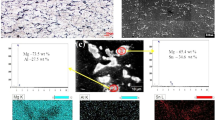Abstract
The hot deformation characteristics of MRI 230D alloy have been evaluated in the temperature range 260-500 °C and strain rate range 0.0003-10 s−1, on the basis of processing map. The processing map exhibited two domains in the ranges: (1) 300-370 °C and 0.0003-0.001 s−1 and (2) 370-480 °C and 0.0003-0.1 s−1. Dynamic recrystallization occurs in the both domains with basal slip dominating in the first domain along with climb as recovery process and second-order pyramidal slip dominating in the second with the recovery by cross-slip. In Domains (1) and (2), the apparent activation energy values estimated using the kinetic rate equation are 143 and 206 kJ/mole, respectively, the first one being close to that for lattice self-diffusion confirming climb. It is recommended that the alloy is best processed at 450 °C and strain rates less than 0.1 s−1, where non-basal slip and cross-slip occur extensively to impart excellent workability. The alloy exhibits flow instability in the form of adiabatic shear band formation and flow localization at lower temperatures and higher strain rates. Forging of a cup-shaped component was performed under various conditions, and the results validated the predictions of the processing map on the workability domains as well as the instability regimes.















Similar content being viewed by others
References
H. Dieringa, Y. Huang, P. Wittke, M. Klein, F. Walther, M. Dikovits, and C. Poletti, Compression Creep Response of Magnesium Alloy DieMag422 Containing Barium Compared with the Commercial Creep-Resistant Alloys AE42 and MRI230D, Mater. Sci. Eng., A, 2013, 585, p 430–438. https://doi.org/10.1016/j.msea.2013.07.041
J. Shen, K. Kondoh, T.L. Jones, S.N. Mathaudhu, L.J. Kecskes, and Q. Wei, Effect of Strain Rate on the Mechanical Properties of Magnesium Alloy AMX602, Mater. Sci. Eng., A, 2016, 649, p 338–348. https://doi.org/10.1016/j.msea.2015.10.022
L. Zhang, K.-K. Deng, K.-B. Nie, F.-J. Xu, K. Su, and W. Liang, Microstructures and Mechanical Properties of Mg-Al-Ca Alloys Affected by Ca/Al Ratio, Mater. Sci. Eng., A, 2015, 636, p 279–288. https://doi.org/10.1016/j.msea.2015.03.100
T. Sato and M.V. Kral, Microstructural Evolution of Mg-Al-Ca-Sr Alloy During Creep, Mater. Sci. Eng., A, 2008, 498, p 369–376. https://doi.org/10.1016/j.msea.2008.08.006
D. Amberger, P. Eisenlohr, and M Göken, Influence of Microstructure on Creep Strength of MRI 230D, Mg Alloy, in 15th International Conference on the Strength of Materials (ICSMA-15), J. Phys. Conf. Ser., IOP Publishing, 2010, 240, 012068; https://doi.org/10.1088/1742-6596/240/1/012068
D. Amberger, P. Eisenlohr, and M. Göken, On the Importance of a Connected Hard-Phase Skeleton for the Creep Resistance of Mg Alloys, Acta Mater., 2012, 60, p 2277–2289. https://doi.org/10.1016/j.actamat.2012.01.017
A. Sadeghi, M. Hoseini, and M. Pekguleryuz, Effect of Sr Addition on Texture Evolution of Mg-3Al-1Zn (AZ31) Alloy During Extrusion, Mater. Sci. Eng., A, 2011, 528, p 3096–3104. https://doi.org/10.1016/j.msea.2010.12.091
A. Sadeghi and M. Pekguleryuz, Recrystallization and Texture Evolution of Mg-3%Al-1%Zn-(0.4-0.8)%Sr Alloys During Extrusion, Mater. Sci. Eng., A, 2011, 528, p 1678–1685. https://doi.org/10.1016/j.msea.2010.10.096
K. Hazeli, A. Sadeghi, M.O. Pekguleryuz, and A. Kontsos, The Effect of Strontium in Plasticity of Magnesium Alloys, Mater. Sci. Eng., A, 2013, 578, p 383–393. https://doi.org/10.1016/j.msea.2013.04.101
B. Ebel-Wolf, F. Walther, and D. Eifler, Influence of Elevated Temperatures on the Cyclic Deformation Behaviour of the Magnesium Die-Cast Alloys AZ91D and MRI230D, Mater. Sci. Eng., A, 2008, 486, p 634–640. https://doi.org/10.1016/j.msea.2007.10.003
A.K. Mondal, A.R. Kesavan, B.R.K. Reddy, H. Dieringa, and S. Kumar, Correlation of Microstructure and Creep Behavior of MRI230D Mg Alloy Developed by Two Different Casting Technologies, Mater. Sci. Eng., A, 2015, 631, p 45–51. https://doi.org/10.1016/j.msea.2015.02.037
Y.V.R.K. Prasad, K.P. Rao, and S. Sasidhara, Hot Working Guide: A Compendium of Processing Maps, 2nd ed., ASM International, Materials Park OH, 2015, ISBN 978-1-62708-091-0
Y.V.R.K. Prasad and T. Seshacharyulu, Modelling of Hot Deformation for Microstructural Control, Int. Mater. Rev., 1998, 43, p 243–258. https://doi.org/10.1179/imr.1998.43.6.243
Y.V.R.K. Prasad and K.P. Rao, Processing Maps and Rate Controlling Mechanisms of Hot Deformation of Electrolytic Tough Pitch Copper in the Temperature Range 300-950 °C, Mater. Sci. Eng. A, 2005, 391, p 141–150. https://doi.org/10.1016/j.msea.2004.08.049
A. Janz, J. Grober, and R. Schmid-Fetzer, Thermodynamics and Constitution of Mg-Al-Ca-Sr-Mn Alloys: Part II. Procedure for Multicomponent Key Sample Selection and Application to the Mg-Al-Ca-Sr and Mg-Al-Ca-Sr-Mn Systems, J. Phase Equilib. Diffus., 2009, 30, p 157–175. https://doi.org/10.1007/s11669-009-9468-3
J.R. Morris, J. Scharaff, K.M. Ho, D.E. Turner, Y.Y. Ye, and M.H. Yoo, Prediction of a 1122 hcp Stacking Fault Using a Modified Generalized Stacking-Fault Calculation, Phil. Mag., 1997, 76, p 1065–1077. https://doi.org/10.1080/01418619708200015
J.J. Jonas, C.M. Sellars, and W.J.M.G. Tegart, Strength and Structure Under Hot Working Conditions, Metall. Rev., 1969, 14, p 1–24. https://doi.org/10.1179/mtlr.1969.14.1.1
H.J. Frost and M.F. Ashby, Deformation-Mechanism Maps. Oxford: Pergamon; 1982, p 44. http://trove.nla.gov.au/work/10811489
K.P. Rao and Y.V.R.K. Prasad, Materials Modeling and Finite Element Simulation of Isothermal Forging of Electrolytic Copper, Mater. Des., 2011, 32, p 1851–1858. https://doi.org/10.1016/j.matdes.2010.12.018
Acknowledgments
The authors would like to thank Mr. C.H. Yuen, Department of Mechanical and Biomedical Engineering, City University of Hong Kong, for his help during the experimental work.
Author information
Authors and Affiliations
Corresponding author
Additional information
Kalidass Suresh and Prasad Yellapregada Venkata Rama Krishna: formerly with City University of Hong Kong.
Rights and permissions
About this article
Cite this article
Suresh, K., Pitcheswara Rao, K., Chalasani, D. et al. Deformation Mechanisms and Formability Window for As-Cast Mg-6Al-2Ca-1Sn-0.3Sr Alloy (MRI 230D). J. of Materi Eng and Perform 27, 1440–1449 (2018). https://doi.org/10.1007/s11665-018-3219-8
Received:
Revised:
Published:
Issue Date:
DOI: https://doi.org/10.1007/s11665-018-3219-8




